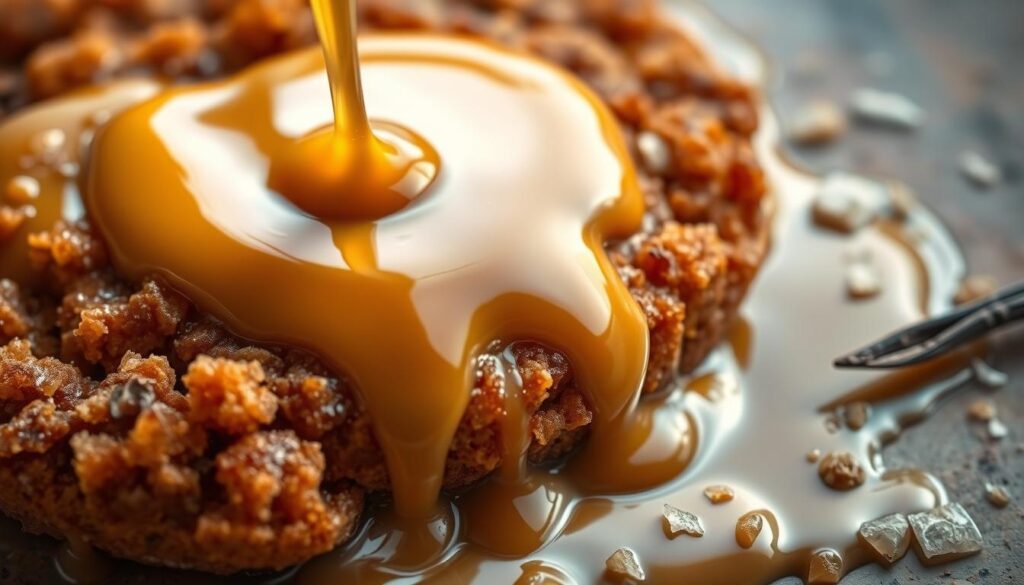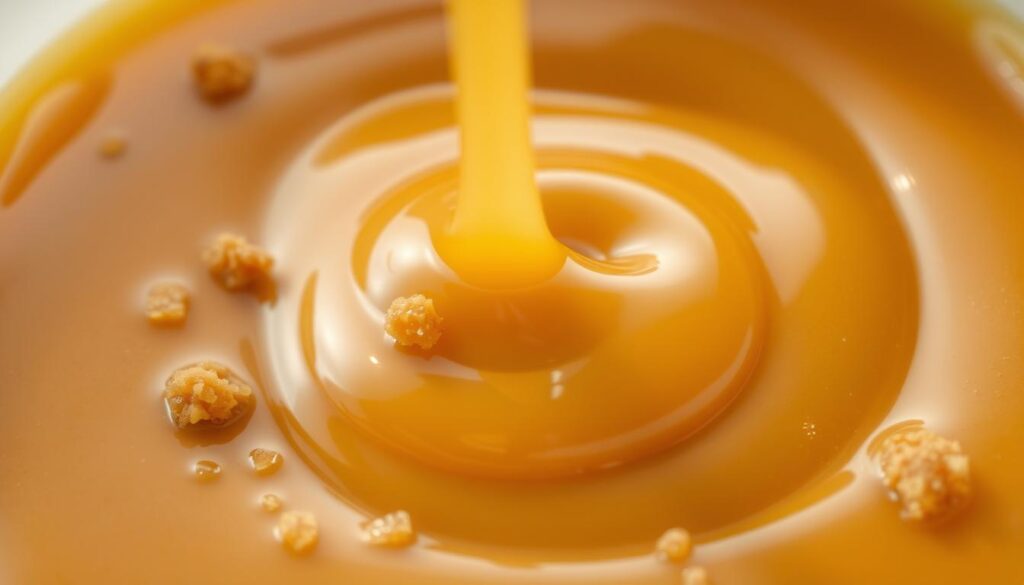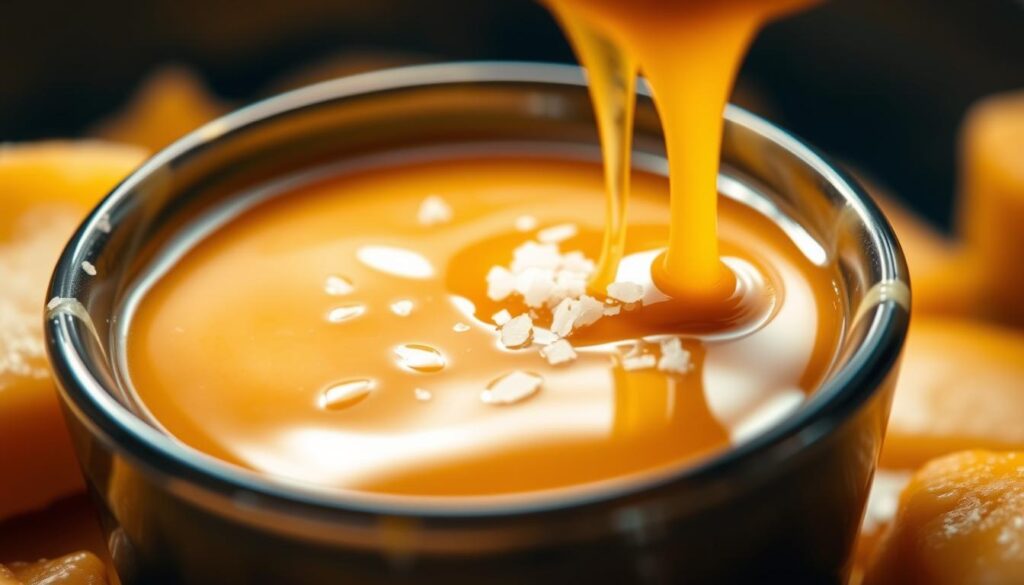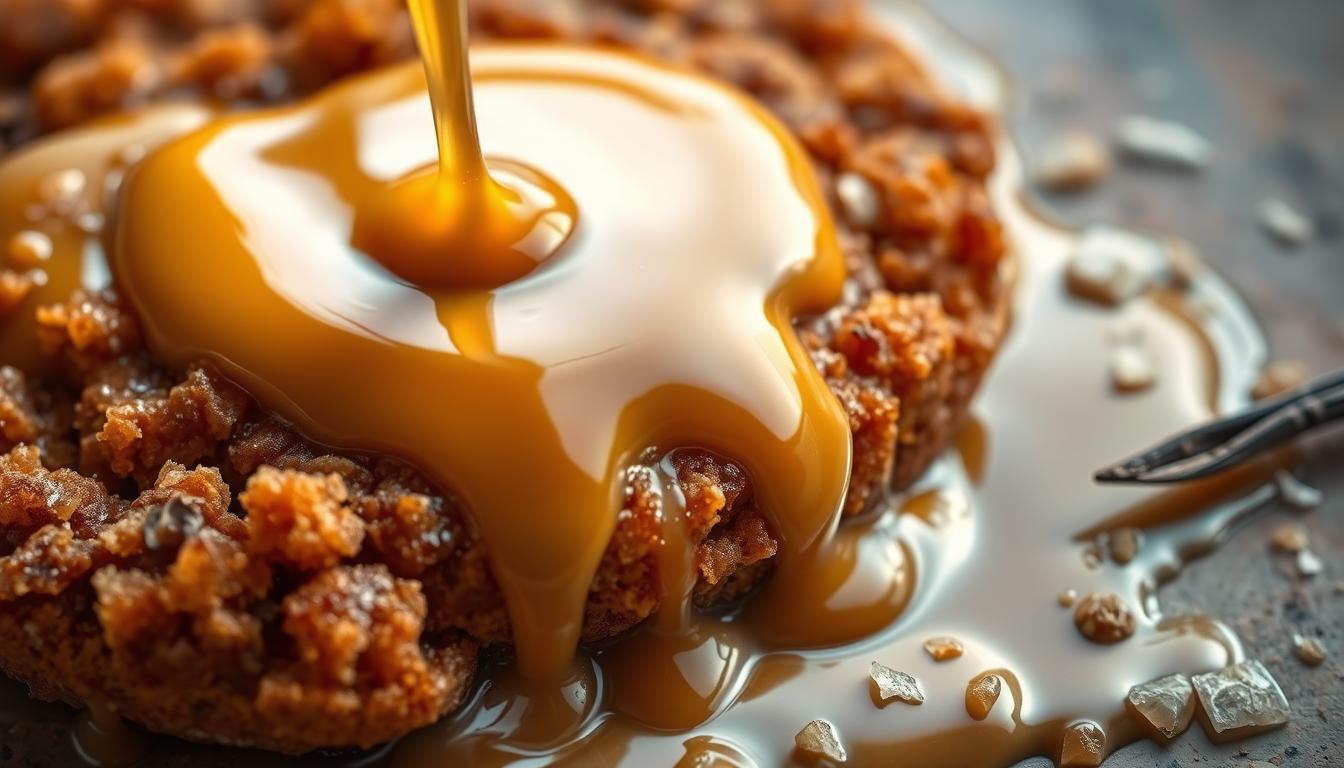What is butterscotch supposed to taste like? Butterscotch is a distinct confection with a rich, sweet flavor profile characterized by a combination of browned butter, caramelized brown sugar (or molasses), and a touch of salt. The unique butterscotch flavor sets it apart from its cousin, caramel, which is made from caramelized white sugar without the addition of butter or molasses. Butterscotch’s flavor is often described as richer, deeper, and more complex than caramel, with a pronounced buttery and brown sugar/molasses note.

Key Takeaways
- Butterscotch has a unique flavor profile that sets it apart from caramel
- The combination of browned butter, caramelized brown sugar, and a touch of salt creates a rich, complex taste
- Butterscotch is often described as richer, deeper, and more complex than caramel
- The addition of molasses in brown sugar gives butterscotch a darker color and deeper flavor
- Butterscotch pairs well with salty flavors and ingredients that cut through its richness
Defining Butterscotch
Butterscotch is a unique and delectable confection that has captivated the taste buds of sweet-lovers for centuries. At its core, butterscotch is a candy made by cooking brown sugar or molasses together with butter until the sugar caramelizes, resulting in a rich, golden-hued treat with a complex, toffee-like flavor profile.
Ingredients for Butterscotch
The key ingredients that define the essence of butterscotch are brown sugar (or molasses), butter, and salt. These simple yet powerful elements come together to create the distinct taste that sets butterscotch apart from other confections.
The Process of Making Butterscotch
To make butterscotch, the butter and brown sugar (or molasses) are slowly heated and stirred together until the mixture reaches the soft-crack stage, typically between 270°F and 289°F. This cooking process allows the sugar to caramelize, developing the signature butterscotch flavor and color.
Interestingly, the term “butterscotch” is believed to have originated in England in the mid-19th century, with the Doncaster Gazette first recording the name in 1817. Over time, this delightful confection has become a beloved staple in both the United Kingdom and the United States, captivating dessert enthusiasts with its irresistible taste and texture.
“Butterscotch in its purest form differs from caramel in that it does not contain dairy, contains more butter than caramel, and also includes syrups that are by-products of sugar manufacturing.”
Distinguishing Butterscotch from Caramel
While butterscotch and caramel may appear similar, they have distinct differences that set them apart. The primary distinction lies in the type of sugar used to create these confections.
Caramel is made by cooking white granulated sugar until it caramelizes, resulting in a straightforward, pure sugar flavor. In contrast, butterscotch is crafted using brown sugar or molasses, which lends it a richer, more complex taste with notes of browned butter and a touch of molasses.
Another key difference is the proportion of butter used. Butterscotch typically contains a higher amount of butter compared to caramel, which contributes to its saltier profile. This increased butter content also gives butterscotch a creamier, more decadent texture.
Ultimately, the choice between butterscotch and caramel comes down to personal preference and the desired flavor profile. Butterscotch offers a more nuanced, layered sweetness, while caramel presents a more straightforward, pure sugar experience.
| Characteristic | Butterscotch | Caramel |
|---|---|---|
| Sugar Used | Brown sugar or molasses | White granulated sugar |
| Flavor Profile | Richer, more complex with notes of browned butter and molasses | Straightforward, pure sugar flavor |
| Butter Content | Higher proportion of butter | Lower proportion of butter |
| Texture | Creamier, more decadent | Varies based on recipe |
| Saltiness | Saltier due to higher butter content | Less salty |
Understanding the nuances between butterscotch and caramel can help you make informed choices when incorporating these flavors into your baking and dessert recipes.
The Unique Flavor Profile of Butterscotch
The distinct flavor of butterscotch is a result of the harmonious blend of several key elements. At the heart of this confection lies the caramelized brown sugar or molasses, which imparts a deep, complex sweetness with hints of caramel and toffee. The addition of browned butter further enhances the flavor, contributing a rich, nutty, and slightly creamy undertone.
Interestingly, the use of brown sugar or molasses in butterscotch sets it apart from traditional caramel, which is made with white sugar. This distinction in the primary sweetening agent is what gives butterscotch its unique taste profile. To balance the sweetness, a touch of salt is often incorporated, rounding out the overall flavor and creating a well-balanced and distinctive treat.
The characteristics of butterscotch flavor are truly captivating, with the caramelized brown sugar or molasses providing a depth of sweetness, the browned butter contributing a rich, nutty essence, and the salt adding a subtle balance. This harmonious interplay of flavors is what makes butterscotch a beloved and distinctive confection.
| Key Butterscotch Flavor Components | Contribution to the Flavor Profile |
|---|---|
| Caramelized Brown Sugar or Molasses | Deep, complex sweetness with hints of caramel and toffee |
| Browned Butter | Rich, nutty, and slightly creamy undertone |
| Salt | Balances the sweetness and rounds out the overall flavor |
The butterscotch flavor profile is a harmonious blend of these key elements, creating a truly distinctive and captivating taste experience.
What is Butterscotch Supposed to Taste Like?
Butterscotch is a delightful confection that’s meant to tantalize the taste buds with its rich, complex flavor. When made correctly, butterscotch is supposed to taste like a decadent combination of caramelized brown sugar (or molasses), browned butter, and a subtle touch of salt. The result is a flavor profile that’s deeper, richer, and more indulgent than its cousin, caramel.
The distinct taste of butterscotch is often described as having notes of toffee, caramel, and a slight nuttiness from the browned butter. Unlike caramel, which has a more straightforward, pure sugar taste, butterscotch is multi-layered and complex, with a pronounced brown sugar or molasses character. This depth of flavor comes from the specific process of cooking the ingredients to the perfect temperature and consistency.
The key to achieving the quintessential butterscotch taste lies in the precise balance of its two primary ingredients: brown sugar (or molasses) and butter. When cooked to the proper “soft crack” stage of 289°F, the sugars caramelize, creating a luxurious, velvety texture and a flavor that’s both sweet and subtly savory. The addition of a touch of salt further enhances the overall taste, rounding out the richness and depth of the butterscotch.
“Butterscotch is a flavor that evokes memories of childhood treats and indulgent desserts. It’s a taste that’s both familiar and exotic, comforting yet complex.”
Whether enjoyed on its own, drizzled over ice cream, or incorporated into baked goods, the unique taste of butterscotch is a true delight for the senses. Its ability to transport us to a state of nostalgic bliss is a testament to the enduring appeal of this beloved confection.
The Role of Brown Sugar in Butterscotch
Butterscotch, the beloved confection, owes its distinctive flavor profile to the use of brown sugar as a key ingredient. Unlike caramel, which is made with white granulated sugar, butterscotch relies on the unique properties of brown sugar to create its signature taste and texture.
Importance of Molasses in Brown Sugar
The molasses content in brown sugar is the secret behind butterscotch’s deep, complex sweetness. This molasses-infused sugar not only adds a rich, caramelized flavor but also contributes to the softer, chewier mouthfeel of butterscotch compared to the harder, more brittle caramel. Without the presence of molasses, butterscotch would lack its distinctive essence and would simply be a pale imitation of its true self.
In fact, the amount of molasses in brown sugar can significantly impact the overall taste and texture of the final butterscotch product. Light brown sugar, with its lower molasses content, will produce a milder, more delicate butterscotch, while dark brown sugar, with its higher molasses concentration, will result in a deeper, more intense flavor profile.
So, the next time you savor a delectable piece of butterscotch, remember the vital role that brown sugar and its molasses-rich goodness play in creating this beloved confection’s unique and irresistible taste.

Butter: The Essential Ingredient
When it comes to the rich, indulgent flavor of butterscotch, butter plays a crucial role. Butterscotch contains a higher proportion of butter compared to caramel, which helps create its distinctive taste and creamy mouthfeel. As the butter is cooked alongside the brown sugar, it browns and develops nutty, toasted notes that perfectly complement the caramelized sugar.
The butter in butterscotch also serves a functional purpose, helping to prevent the sugar from crystallizing and resulting in a smooth, velvety texture in the final product. This higher butter content sets butterscotch apart from its cousin, caramel, which typically uses a lower ratio of butter and a higher proportion of white sugar.
| Ingredient | Butterscotch | Caramel |
|---|---|---|
| Sugar | Brown sugar | White sugar |
| Butter | Higher proportion | Lower proportion |
| Flavor Profile | Richer, more complex | Simpler, less nuanced |
Without the essential contribution of butter, butterscotch would lose its signature creaminess and depth of flavor. The butter in butterscotch is truly what sets this beloved confection apart, creating an indulgent experience that’s hard to resist.
The Significance of Salt in Butterscotch
Salt plays a crucial role in creating the perfect butterscotch flavor. While the caramelized brown sugar and butter provide the foundation for this beloved confection, a touch of salt is essential to balance the sweetness and bring out the other nuanced flavors.
The addition of a pinch of salt, or the use of salted butter, helps to offset the inherent cloying nature of the caramelized sugars. This simple seasoning acts as a counterpoint, enhancing the nutty, toasted notes of the browned butter and creating a more complex and sophisticated taste profile.
In fact, some recipes call for up to a teaspoon of salt to truly elevate the butterscotch experience. The salt helps to unlock the full potential of the brown sugar, allowing its caramel-like notes to shine through without being overpowered by sweetness.
| Ingredient | Ideal Temperature Range | Sugar Concentration |
|---|---|---|
| Butterscotch | 270 to 289°F | 95% |
| Toffee | 295 to 309°F | 99% |
| Caramel | 244 to 248°F | 87% |
The role of salt in butterscotch is not to be underestimated. It helps to balance the confection’s inherent sweetness, creating a more harmonious and well-rounded taste that is sure to delight the senses.

“Butterscotch is often made with brown sugar, while caramel is frequently made with white granulated sugar.”
Homemade vs. Store-Bought Butterscotch
When it comes to butterscotch, the difference between homemade and store-bought versions is night and day. While homemade butterscotch is a rich, creamy delight that tantalizes the taste buds, store-bought butterscotch often falls flat, tasting artificial and lacking the depth of flavor that true butterscotch should possess.
Why Store-Bought Butterscotch Tastes Awful
The primary reason store-bought butterscotch falls short is the use of inferior ingredients. Homemade butterscotch is crafted with just a few simple, high-quality components like butter, brown sugar, and salt. In contrast, store-bought butterscotch is typically laden with a long list of artificial flavorings, preservatives, and other additives that give it a synthetic, flat taste.
Additionally, store-bought varieties may use cheaper or lower-quality ingredients, further compromising the flavor. The end result is a butterscotch that lacks the caramelized complexity, buttery richness, and perfect balance of sweetness and saltiness that makes homemade butterscotch such a treat.
“Store-bought butterscotch often contains a long list of artificial flavorings, preservatives, and other additives, resulting in a flat, synthetic taste that pales in comparison to the depth and richness of homemade butterscotch.”
For a truly exceptional butterscotch experience, the choice is clear: homemade is the way to go. With just a few simple ingredients and a little time and effort, you can create a butterscotch masterpiece that will have your taste buds singing with delight.
Popular Butterscotch Recipes
Butterscotch is a beloved flavor that shines in a variety of decadent desserts. From creamy puddings to indulgent candies and cookies, this versatile ingredient can elevate any sweet treat. Let’s explore some of the most popular butterscotch recipes that are sure to delight your taste buds.
One of the classics is Butterscotch Pudding. This rich and silky dessert starts with a base of whole milk, heavy cream, and egg yolks, combined with dark brown sugar to create the signature butterscotch flavor. The recipe takes a bit of time and attention, but the result is well worth it – a luxurious pudding that’s perfect for enjoying on its own or as a topping for cakes and pies.
Another crowd-pleaser is Butterscotch Sauce. This versatile topping can be drizzled over ice cream, used as a dip for apples, or even incorporated into baked goods like cheesecake. The key to a great butterscotch sauce is the perfect balance of butter and brown sugar, simmered until it develops a deep, caramelized flavor.
For those who love a bit of crunch, Butterscotch Cookies are a delightful option. These cookies feature the classic butterscotch flavor, with the added texture of chopped nuts or toffee bits. They’re perfect for satisfying a sweet tooth or sharing with friends and family.
Finally, let’s not forget the indulgent Butterscotch Crème Brûlée. This rich and creamy custard-based dessert is elevated with the addition of butterscotch, creating a unique and unforgettable flavor experience. The contrast of the crisp caramelized top and the silky smooth custard is simply divine.
Whether you’re in the mood for a comforting pudding, a decadent sauce, or a batch of irresistible cookies, these popular butterscotch recipes are sure to delight. Embrace the warm and indulgent flavors of butterscotch and let it elevate your dessert game.
Conclusion
Butterscotch is a truly unique and beloved confection with a rich, complex flavor profile that sets it apart from its cousin, caramel. The captivating combination of caramelized brown sugar or molasses, browned butter, and a touch of salt results in a deep, indulgent taste that is both sweet and subtly savory. Whether enjoyed as a standalone candy, drizzled over ice cream, or incorporated into various desserts, the distinctive flavors of butterscotch make it a true standout in the world of sweets.
From its origins in Yorkshire, England, to its enduring popularity as a versatile ingredient in baking and confectionery, butterscotch has carved out a special place in the hearts and palates of sweet enthusiasts around the world. Its unique taste and texture offer a delightful alternative to the ubiquity of chocolate, providing a sweet, comforting, and sophisticated culinary experience that is sure to captivate the senses.
As we’ve explored the nuances of butterscotch’s flavor profile, the importance of its key ingredients, and the various ways it can be enjoyed, it’s clear that this enduring confection is much more than just a simple syrup or candy. Butterscotch is a testament to the art of culinary craft, a delightful fusion of sweet and savory that continues to delight and inspire generations of dessert enthusiasts. Whether you’re a lifelong butterscotch devotee or a newcomer to its charms, there’s no denying the timeless appeal of this unique and beloved confection.
FAQ
What is butterscotch supposed to taste like?
Butterscotch is a distinct confection with a rich, sweet flavor profile characterized by a combination of browned butter, caramelized brown sugar (or molasses), and a touch of salt. The unique taste of butterscotch sets it apart from its cousin, caramel, which is made from caramelized white sugar without the addition of butter or molasses. Butterscotch’s flavor is often described as richer, deeper, and more complex than caramel, with a pronounced buttery and brown sugar/molasses note.
What are the ingredients for making butterscotch?
The key ingredients for making butterscotch are brown sugar (or molasses), butter, and salt. To make butterscotch, the butter and brown sugar are cooked together until the sugar caramelizes and the mixture takes on a rich, golden-brown color and deep, complex flavor.
What is the process of making butterscotch?
The process of making butterscotch involves slowly heating and stirring the butter and brown sugar mixture until it reaches the soft-crack stage, between 270°F and 289°F.
What is the main difference between butterscotch and caramel?
The main difference between butterscotch and caramel is the type of sugar used. Caramel is made by cooking white granulated sugar until it caramelizes, while butterscotch is made with brown sugar or molasses. Butterscotch also contains a higher proportion of butter compared to caramel. Additionally, butterscotch tends to be saltier than caramel due to the higher butter content.
What is the unique flavor profile of butterscotch?
The unique flavor profile of butterscotch is a result of the interplay between the caramelized brown sugar or molasses, browned butter, and a touch of salt. The brown sugar or molasses provides a deep, complex sweetness with hints of caramel and toffee, while the browned butter adds a rich, nutty, and slightly creamy element. The salt helps to balance the sweetness and round out the overall flavor, creating a well-balanced and distinctive taste that sets butterscotch apart from other confections.
What is the role of brown sugar in butterscotch?
Brown sugar is an essential ingredient in butterscotch, as it provides the base for the confection’s characteristic flavor profile. The molasses content in brown sugar is what gives butterscotch its deep, complex sweetness and distinguishes it from caramel, which is made with white granulated sugar. The molasses in brown sugar also contributes to the softer, chewier texture of butterscotch compared to the harder, more brittle caramel.
Why is butter an essential ingredient in butterscotch?
Butter is an essential ingredient in butterscotch, playing a vital role in the confection’s flavor and texture. Butterscotch contains a higher proportion of butter compared to caramel, which helps create its rich, indulgent mouthfeel and distinctive taste. As the butter is cooked along with the brown sugar, it browns and develops nutty, toasted notes that complement the caramelized sugar.
What is the significance of salt in butterscotch?
Salt is a crucial component in butterscotch, as it helps to balance the confection’s inherent sweetness and bring out the other flavors. The addition of a pinch of salt, or the presence of salted butter, offsets the cloying nature of the caramelized brown sugar and butter, creating a more harmonious and well-rounded taste.
Why is homemade butterscotch better than store-bought?
Homemade butterscotch is vastly superior in taste and quality compared to store-bought versions. The key difference lies in the ingredients used – while homemade butterscotch is made with just a few simple, high-quality ingredients like butter, brown sugar, and salt, store-bought butterscotch often contains a long list of artificial flavorings, preservatives, and other additives.
What are some popular butterscotch recipes?
Some of the most popular butterscotch recipes include butterscotch pudding, butterscotch ice cream, butterscotch sauce for topping sundaes and cakes, and butterscotch-flavored candies and cookies. Butterscotch also makes an excellent base for rich, indulgent desserts like butterscotch crème brûlée, butterscotch billionaire bars, and butterscotch-swirled cheesecake.

